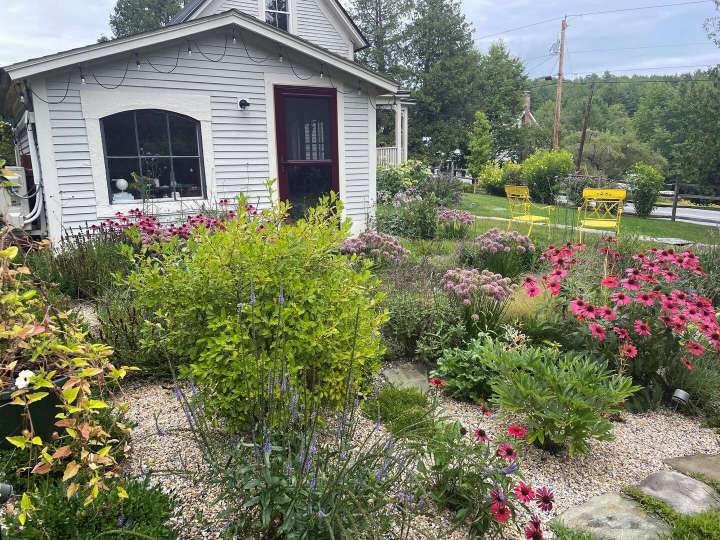Last summer, my partner, Andrew, and I planted a pollinator garden in a small patch of yard outside our home in Vermont. We thought that maybe we’d attract a few endangered monarchs, but word got out fast, and we ended up building the hottest pollinator bar in town.
Creating a garden as a refuge for pollinators — and myself

I roamed through the garden in the morning when many of the bees were still asleep from the prior day’s feast. I’d find them still clinging to a beloved purple hyssop, the weight of a bee significant enough to bend a delicate stem. By midday, they moved on to blue star amsonia, Little Trudy catmint, sea holly and pasqueflower, which bloomed early in the season and provided food to pollinators building their nests.
The garden was a welcome distraction during a difficult time. Andrew and I had been trying to have a baby, with no success. Each month that passed brought hope, then disappointment. I thought that pruning and weeding the garden would take my mind off all the uncertainty, but the garden barely required maintenance. The pollinators seemed to love its wildness. A few times, I donned gardening gloves and carried pruning shears outside to deadhead stems and prove to the neighbors that I was a real gardener, but the bees wouldn’t stand for it. It was the only time they noticed me. They swarmed around my head as if to say: “I’m not done with that yet!”
Halfway through the summer, my father fell ill with a heart problem that put him in the hospital. On hot afternoons, I sat at his bedside in Ohio in a sterile hospital room, wishing for normalcy. I missed walking outside to the chirpy song of a red-winged blackbird first thing in the morning, the downy woodpeckers tapping away on our old maple tree.
Andrew sent photos of the garden to keep me going. It had been a dry summer, but the lavender Phenomenal was still thriving despite the heat, and so was the garden phlox, a favorite of the hummingbird clearwing moth.
The garden was as beautiful as ever when I returned to Vermont at the end of the summer, my father finally released from the hospital. The bumblebees were loving a thick mat of woolly thyme growing around a stone path, their hum audible through an open window. Autumn Joy sedum and speedwell, a purple flower that reminded me of a gnome’s hat, were still going strong.
Even after the first frost arrived that fall, the garden delivered blessings. I snipped the stems off a lavender plant and sprinkled them in a warm bath after painful fertility treatments. It felt healing to submerge my body in the lavender, something that had brought the pollinators so much pleasure.
All the leaves had fallen by the time we put the garden to bed. We covered Green Velvet boxwood plants with burlap and draped pine boughs over the lavender to shield it from the cold. A New England winter is not for the faint of heart. A few months of darkness can seem like a lifetime. I lit candles and stared out the window at the garden, hibernating under a mound of snow. As the days slowly got longer, the bright berries produced by a Red Sprite winterberry shrub and its male pollinator companion, a Jim Dandy holly, provided food for black-capped chickadees and northern cardinals in the garden.
When spring finally arrived, we unwrapped the boxwood. Canary yellow narcissus Baby Moon daffodils had started pushing up through the soil. We removed the pine boughs and found the unexpected: a bird’s nest hidden underneath. The occupants were long gone, probably catching insects out in the world or perhaps grazing at our bird feeder. The nest was an extraordinary creation. The bird had used strands of twine from our burlap and garnished it with pieces of lavender. The pollinator garden had done for the birds just what it did for me: provide a safe place to weather life’s harshness.
Summer has come and gone once again. I have no children, but I have had pollinators, far too many to count. On sunny days, they dined on strands of purpletop vervain, an annual plant that magically returned in other parts of the garden this year, its seeds carried by the wind. The stems look out of place where they are, but I wouldn’t dream of clipping them. They remind me of the beauty that comes with letting go.
Betsy Vereckey is a freelance writer in Vermont. Find her online at betsyvereckey.com.






